Keeping your water ionizer in top shape means replacing filters regularly. Tyent’s MMP line of countertop alkaline ionizers makes how to replace water ionizer filters easy. They ensure the filter change process is simple and stress-free.
Water ionizers are key in making your tap water clean and full of minerals. They turn your water into something healthy and full of antioxidants. To keep your Tyent ionizer working well, it’s important to know how to change the filters right.
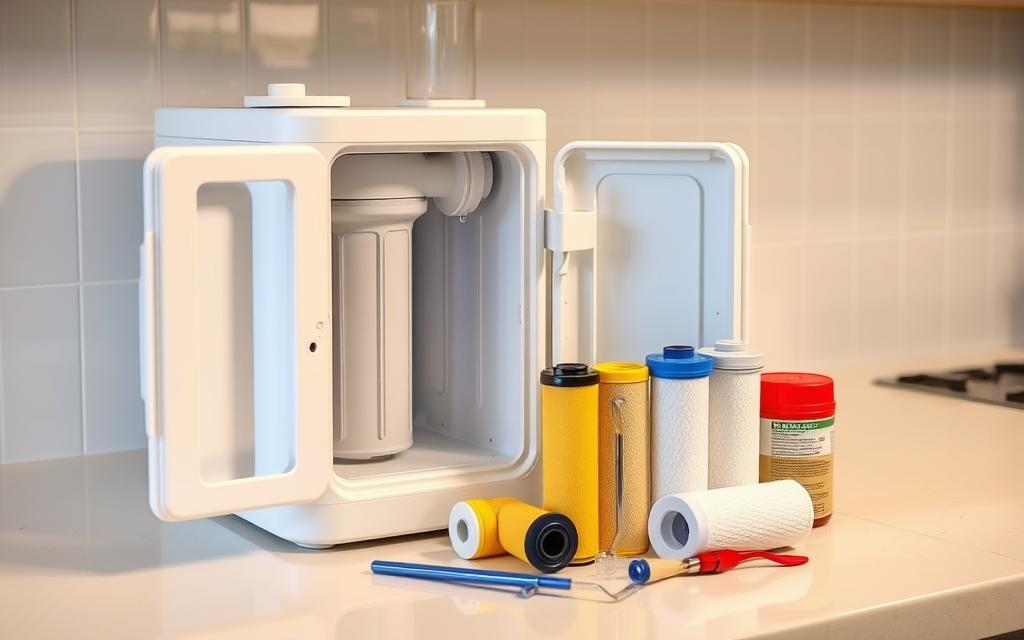
Key Takeaways
- Tyent’s countertop ionizers feature a dual filtration system for optimal water purification.
- The primary filter removes large contaminants, while the secondary filter balances the water’s mineral content.
- Filters need to be replaced periodically as they deteriorate over time with extended use.
- The filter replacement process involves simple steps like accessing the filter compartment, identifying and replacing the filters, and resetting the system.
- Visiting the Tyent website is recommended for purchasing replacement filters and learning more about your specific ionizer model.
Understanding Water Ionizers and Their Filters
Water ionizers are cool devices that break down water into hydrogen and oxygen. They have a dual filter system for the cleanest water. The first filter uses ACF active carbon to get rid of big contaminants like organic stuff, chlorine, and sediment. The second filter uses ceramic to balance the water’s ions and minerals.
What is a Water Ionizer?
A water ionizer turns regular tap water into alkaline and acidic water. It filters out bad stuff like chlorine and bacteria first. Then, it uses electrolysis to split the water into ionized streams.
Importance of Regular Filter Replacement
Changing your water ionizer’s filters often is key to keeping your water clean and your device working well. Filters get clogged with contaminants over time. This can make them less effective and even damage your ionizer. Replacing filters regularly helps keep your water fresh and your ionizer in top shape.
| Filter Type | Purpose | Replacement Frequency |
|---|---|---|
| Sediment Filter | Removes larger particles like rust, sand, and silt | Every 6-12 months |
| Activated Carbon Filter | Reduces chlorine, organic compounds, and other contaminants | Every 6-12 months |
| Reverse Osmosis Filter | Removes dissolved solids, heavy metals, and minerals | Every 12-24 months |
“Molecular hydrogen in water offers health benefits as a selective antioxidant and is more effective than other antioxidants due to its small molecule size.”
Types of Water Ionizer Filters
Water ionizers use different filters to clean water well. The main filter often has activated carbon. It removes big contaminants and makes water taste better. Some systems also have ceramic filters to balance water’s pH and minerals.
Sediment Filter
Sediment filters catch dirt, rust, and sand. They protect the ionizer’s delicate parts. This ensures clean water goes into the system.
Activated Carbon Filter
Activated carbon filters are key in many ionizers. They remove chlorine, VOCs, and other bad stuff. They also make water taste and smell better.
Reverse Osmosis Filter
Some ionizers have a reverse osmosis (RO) filter too. RO filters get rid of heavy metals, minerals, and even germs and viruses. They’re a strong extra cleaning step.
Choosing the right filters depends on the ionizer model and your water needs. Talk to the maker or a water expert. They can help pick the best filters for you and your budget.
| Filter Type | Function | Typical Performance |
|---|---|---|
| Sediment Filter | Removes larger particles like dirt, rust, and sand | Excellent for trapping coarse impurities |
| Activated Carbon Filter | Removes chlorine, VOCs, and improves taste and odor | Outstanding for reducing common contaminants |
| Reverse Osmosis Filter | Removes a wide range of contaminants, including heavy metals and bacteria | Exceptional for comprehensive water purification |
“The right combination of filters in a water ionizer can truly transform the quality and taste of your drinking water.”
Identifying When to Replace Filters
Keeping your water ionizer in top shape is key. Replacing filters on time is a big part of that. Water ionizer filters only last so long. If you ignore the signs they need a change, your water and ionizer quality will suffer.
Signs Your Filters Need Changing
- Noticeable drop in water taste or quality
- Reduced water flow or pressure
- Increased mineral or sediment buildup in the ionizer
- Indication from the ionizer’s filter change indicator light or notification
General Replacement Timeline
Most water ionizer filters can filter about 950 gallons of water before needing a swap. This usually means about 6 months of regular use. But, the exact time can change based on water quality, how often you use it, and the filter type. Always watch your ionizer’s performance and replace filters as the maker suggests. This keeps your water and ionizer working well.
| Filter Type | Typical Replacement Interval |
|---|---|
| Sediment Filter | 3-6 months |
| Activated Carbon Filter | 6-12 months |
| Reverse Osmosis Filter | 12-24 months |
Remember, replacing filters regularly is vital for your water ionizer’s performance and life. By staying on top of replacements, you get clean, tasty water. And your ionizer will keep working great.
Tools and Supplies Needed for Replacement
Replacing filters in your water ionizer is easy and doesn’t need special tools. We aim to make it simple so you can keep your ionizer working well.
Essential Tools
You’ll need a few basic tools for the job. These include:
- A pair of pliers or filter wrench to remove the old filters
- A clean, damp cloth for cleaning the filter housing
- A bucket or container to catch spills
Recommended Replacement Filters
Choosing the right replacement filters is key. Use diy ionizer filter change products for the best results. Opt for compatible ionizer filter brands made for your model. This keeps your system working well and your water clean.
| Replacement Filter Kit | Included Components |
|---|---|
| DI Purifier & Filter Replacement Kit (K082-004) |
|
| RO Membrane Replacement Kit (K082-006) |
|
| Maintenance Tool Set (K082-007) |
|
If your ionizer is older than 2009, contact the maker to find the right filters for it.
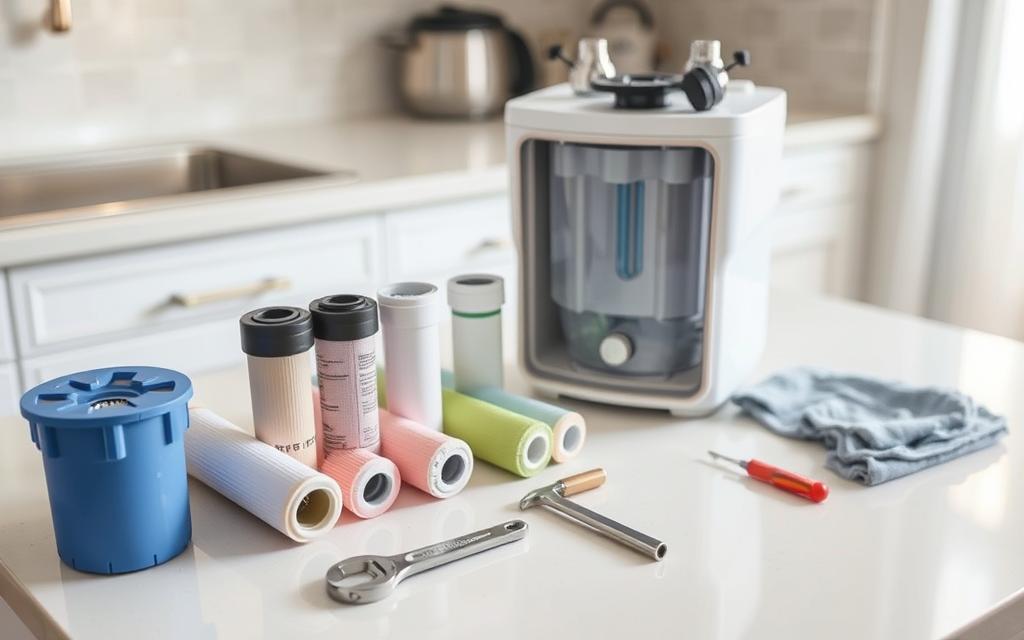
“Terrence and Greg provide excellent customer service, and the 14-Stage Water Purification System receives praise for its quality and long-term support.”
Step-by-Step Guide to Replacing Filters
Regular maintenance is key to keeping your water ionizer in great shape. Replacing the filters is a crucial part of this. This guide will show you how to change your ionizer filters. This way, your water will stay fresh and clean.
Step 1: Turn Off the Water Supply
First, turn off the water supply to your water ionizer. This step is important to avoid water leaks while you replace the filters.
Step 2: Remove the Old Filter
Find the primary (blue) and secondary (green) filters on your ionizer. Twist them counterclockwise to remove them. Then, throw away the old filters.
Step 3: Install the New Filter
Put the new filters into the filter housings. Twist them clockwise to lock them in place. Be careful not to overdo it. After installing, turn the water supply back on and check for leaks.
Run the new filters for about 3 minutes until the water is clear. This step helps get rid of any air or impurities from the replacement.
By following these easy steps, you can change your ionizer filters step-by-step. Enjoy clean, fresh water from your water ionizer filter replacement guide.
Cleaning Your Water Ionizer
Keeping your water ionizer clean is key for its best performance and filter life. Regular cleaning stops mineral buildup. This ensures your ionizer keeps giving you fresh, clean, and healthy water.
Importance of Cleaning
Hard water can lead to scaling and clogging in ionizers. Look out for signs like a drop in pH, slow flow, whitish film, and needing more filter replacements.
Recommended Cleaning Solutions
- Vinegar is great for cleaning ionizers. It breaks down calcium clogging and scale.
- Some makers offer special cleaning cartridges or solutions. Always follow the manufacturer’s cleaning guide for your model.
- Dishwashing soap, like Dawn, is another option for soft water areas. Use about 5 drops every 6 months.
Models with continuous cleaning, like Tyent USA’s, keep electrodes clean. But, hoses and connectors need cleaning too, to avoid hard water buildup.
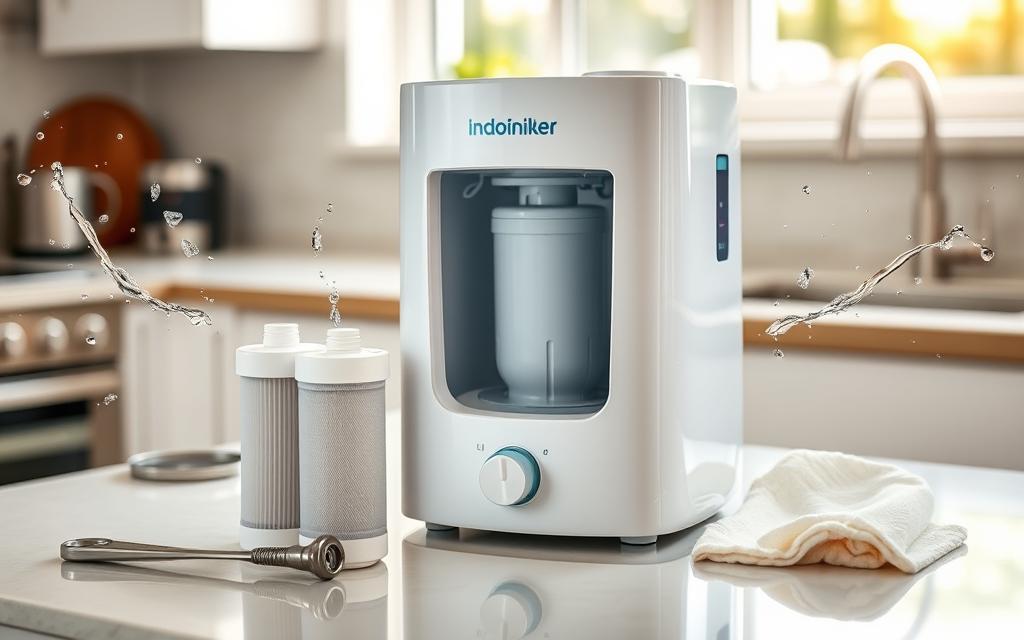
Regular cleaning, as the maker suggests, is vital. It keeps your ionizer working well and its filters lasting longer. By cleaning right, your ionizer will keep giving you fresh, clean water for years.
Troubleshooting Common Issues
Keeping your water ionizer in good shape is key to getting clean water. But, you might still run into some problems after changing the filters. Here are a few tips to help you fix these issues.
Leaks After Filter Replacement
Seeing leaks after filter change? First, check if the filters are correctly fitted and tightened. Make sure you followed the maker’s guide and the filters are snug. Also, look for any wear or damage on the filter housing and connections that could be causing the leak.
Poor Water Quality
Poor water quality after filter change is another common problem. It might be because of a few reasons. First, ensure you’ve put in the right filters for your water ionizer model. Using the wrong filters can lead to poor water quality.
Also, let the water run through the system for a few minutes after changing the filters. This clears out any air or residue from the filter change. If the water quality doesn’t improve, check the manufacturer’s support or contact their customer service for help.
By tackling these common problems, you can keep your water ionizer working well. Regular upkeep and watching your system closely will help you enjoy its benefits for a long time.
Maintaining Your Water Ionizer
To keep your water ionizer working well, regular checks and care are key. Not taking care of it can lower the quality of your water and shorten its life.
Regular Inspection
Start by regularly checking your water ionizer. Look at the filters, connections, and how it’s working. Watch for wear, leaks, clogs, or odd sounds. Fixing these issues early can help your ionizer last longer and extend the life of your ionizer filter.
Best Practices for Longevity
- Stick to the maker’s ionizer filter maintenance and replacement plans. Replacing filters on time keeps your water quality high.
- Keep the ionizer clean from dust and dirt. Regularly clean the outside and inside parts.
- Use good water sources and avoid extreme temperatures or high humidity. These can harm your ionizer.
- Do vinegar washes to remove mineral buildup, which is more common in hard water areas. Make sure to unplug the ionizer first.
- Keep the water flow rate right, usually around 1.5 liters per minute. This helps get the best water quality.
By following these best practices for ionizer filter maintenance, you can make your water ionizer last longer. Enjoy fresh, clean, and healthy alkaline-ionized water for many years.
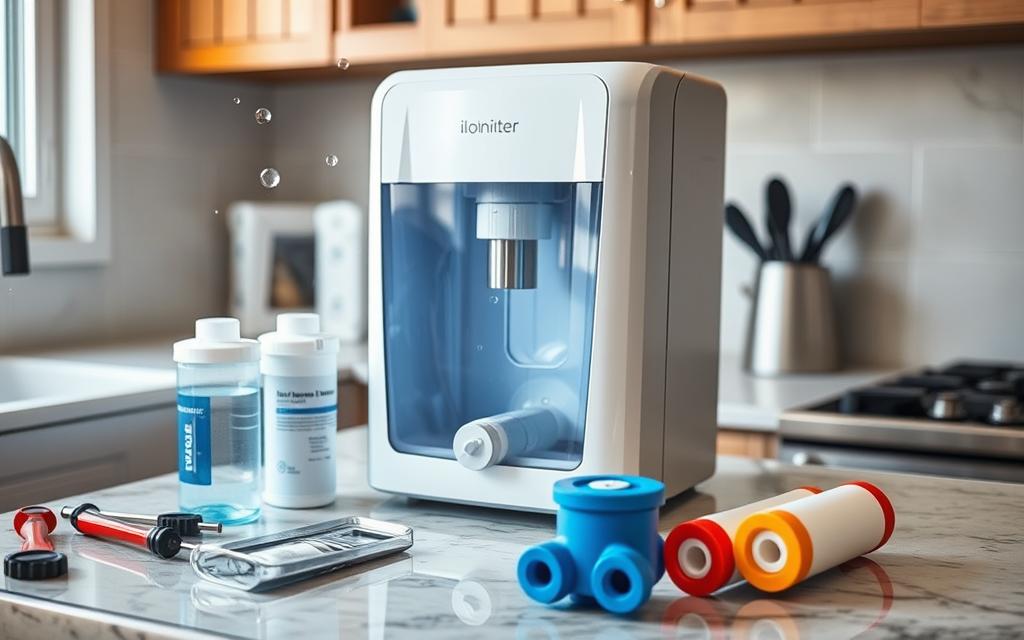
Frequently Asked Questions (FAQs)
Many people wonder how often to replace their water ionizer filters. The usual advice is to swap them out every 6 months. This is after filtering about 950 gallons of water. But, the exact time might change based on your water’s quality and how much you use it.
Another common question is if you can replace the filters yourself. The answer is yes, most water ionizers, like Tyent’s, are made for DIY filter changes. This means you can do it yourself without needing a pro. With a few easy steps, you can keep your water ionizer working well, giving you clean, healthy water.
How Often Should I Replace My Filters?
- Tyent water ionizer filters usually need a swap after filtering about 950 gallons of water, which is roughly every 6 months with regular use.
- The exact time for replacement can change based on your water’s quality and how much you use it.
- It’s key to watch how your water ionizer works and replace the filters when needed to keep the water quality high.
Can I Replace Filters Myself?
Yes, you can replace the filters in your water ionizer by yourself. Most models, including Tyent’s, are made for easy DIY filter replacement. This lets you do the maintenance yourself without needing a pro. Just follow the maker’s instructions, and you can replace the filters quickly and easily.
“Maintaining your water ionizer with regular filter changes is crucial for ensuring your water stays fresh, clean, and healthy.”
Environmental Benefits of Using Water Ionizers
Getting a high-quality water ionizer brings many environmental perks. It gives you fresh, clean, and customizable drinking water. It also helps cut down on plastic waste and water use, making your lifestyle greener.
Reducing Plastic Waste
Water ionizers are great for cutting down plastic waste. They make it easy to ditch bottled water. Bottled water production and transport lead to a lot of plastic waste, which takes ages to break down.
With a water ionizer, you can get great-tasting, filtered water right from your tap. This means less need for single-use plastic bottles.
Saving Water
Water ionizers also help save water. They offer a direct and efficient way to get clean, purified water. Unlike bottled water, which needs a lot of energy to make and ship, a water ionizer lets you get water straight from your tap.
While buying a water ionizer and replacing filters costs money upfront, the long-term benefits are huge. You’ll cut down on plastic waste and water use. This helps make your community and the planet cleaner and greener.
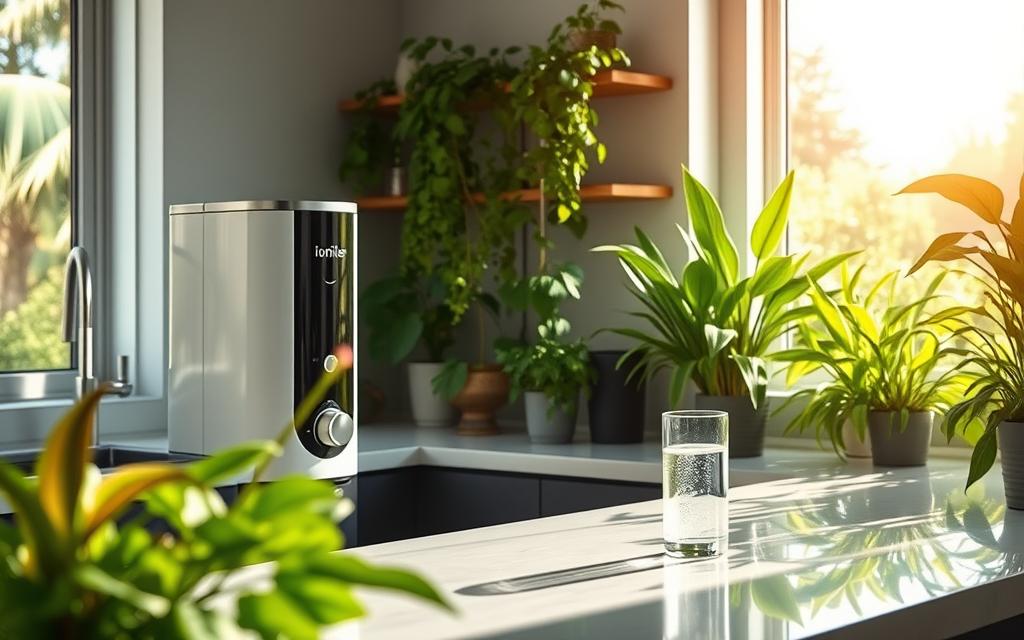
Choosing the Right Replacement Filters
Choosing the right replacement filters for your water ionizer is key. Tyent suggests using their branded filters for the best results. But, you might find other brands that work well too. Look at the filter’s lifespan, how well it filters, and the cost to find the best deal.
Compatible Brands
Here are some brands you might consider:
- Aqua-Pure by 3M
- Aquasana
- Brita
- Brondell
- Crystal Quest
- Culligan
- Everpure by Pentair
- Multipure
- Pur
- Soma
- ZeroWater
These brands have many types of filters. They range from pitcher-style to under-sink and countertop systems. Make sure to check if they fit your water ionizer model and meet your needs.
Cost Considerations
Ionizer replacement filters come in different prices. Pitcher-style filters are under $50. Faucet-mounted filters are also around $50. Countertop filters can cost between $80 and over $1,000.
Under-sink filters vary from under $100 to $700. While cost matters, don’t forget about quality and effectiveness. Good filters will make your water ionizer last longer and work better, giving you clean water for years.
Conclusion: Enjoying Fresh and Clean Water
Keeping your water ionizer in good shape is key. This means regular filter changes for clean, ionized water. It’s good for your health, keeps you hydrated, and helps the planet.
Follow the maker’s ionizer filter maintenance tips. This way, you get the most out of your water ionizer. You’ll have great water quality and your ionizer will last longer.
Long-Term Benefits of Proper Maintenance
Changing your water ionizer filters as suggested is vital. It keeps your system working well and gives you fresh water. This makes your water taste better and saves you money on replacements.
Good care also makes your ionizer last longer. You’ll enjoy years of use and feel good about your eco-friendly choice.
By focusing on your water ionizer’s health and the planet, you gain a lot. You’ll stay hydrated, cut down on plastic, and live more sustainably. Remember, small actions like filter changes can greatly improve your life and the environment.
Leave a Reply